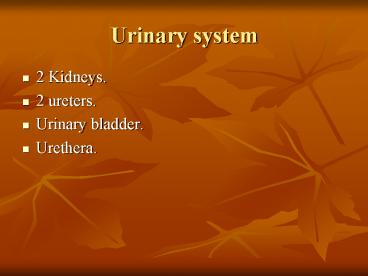Urinary system - PowerPoint PPT Presentation
1 / 37
Title:
Urinary system
Description:
Title: PowerPoint Presentation Created Date: 1/1/1601 12:00:00 AM Document presentation format: On-screen Show (4:3) Other titles: Times New Roman Arial Wingdings ... – PowerPoint PPT presentation
Number of Views:81
Avg rating:3.0/5.0
Title: Urinary system
1
Urinary system
- 2 Kidneys.
- 2 ureters.
- Urinary bladder.
- Urethera.
2
A hemisected vew of the kidney
3
Kidney
- Cortex---Dark brown and granular.
- Medulla---6-12 pyramid-shape regions (renal
pyramids) - The base of pyramid is toward the cortex
(corticomedullary border) - The apex (renal papilla) toward the hilum that
perforated by 12 openings of the ducts of Bellini
in region called area cribrosa . The apex is
surrounded by minor calyx. - Pyramids are separated by cortical columns of
Bertin - 3or4 minor calyces join to form 3or 4 major
calyces that form renal pelvis.
4
Cortical arch
- Is formed of
- Renal corpuscles (red dots).
- Convoluted tubules
- (cortical labyrinth).
- Medullary rays
- (cortical continuation of pyramids).
- NB. Lobe of the kidney is formed of
- a- Renal pyramid.
- b-Cortical columns.
- c-Cortical arch
- Each medullary ray with part of the cortical
labyrinth surrounding it form kidney lobule.
5
(No Transcript)
6
Uriniferous tubule
- Is the functional unit of the kidney.
- Is formed of
- 1- Nephron.
- 2-Collecting tubule.
- They are densely packed.
- They are separated
- by thin stroma
- and basal lamina.
7
Nephron
- There are 2 types
- a-Cortical nephrons.
- b-Juxtamedullary nephrons.
- It is formed of
- 1-Renal corpuscle.
- 2-Proximal tubule.
- 3-Thin limbs of Henles loop.
- 4-Distal tubule
8
Renal corpuscle
- Glomerulus (tuft of fenestrated capillaries)
- Bowmans capsule (Parietal layer, urinary or
glomerular space and visceral layer or
podocytes). - Mesangial cells (intraglomerular
extraglomerular).
9
Renal cortex
Renal corpuscle
10
(No Transcript)
11
Blood-Renal Barrier
12
(No Transcript)
13
(No Transcript)
14
Filtration barrier
- Endothelial wall of the capillaries.
- The basal lamina (inner and outer laminae rarae
and middle lamina densa). - Visceral layer of Bowmans capsule (podocytes)
- Podocytes have primary (major) processes and
secondary (minor) processes (pedicles). - Between pedicles (on the surface of capillaries)
there are filtration slits that - have slit diaphragm
15
(No Transcript)
16
Proximal tubule
- It has 2 regions
- 1-Pars convoluta (Proximal convoluted tubule).
- 2-Pars recta (descending thick limb of Henles
loop). - It is composed of simple
- cuboidal epith.with acidophilic
- cytoplasm. The cells have striated
- or brush border and lateral
- interdigitations. They have
- well-defined basal lamina.
17
Cell of proximal tubule
18
Thin limb of Henles loop
- It has 3 regions
- 1-Descending thin limb.
- 2-Henles loop.
- 3-Ascending thin limb.
- NB. It is longer in juxtamedullary
- nephron than in cortical nephron.
- It is composed of simple
- squamous epith.
19
Renal medulla
20
Distal tubule
- It has 3 regions
- 1-Ascending limb of Henles loop (low cuboidal
epith.). - 2-macula densa (tall narrow cells).
- 3-Pars convoluta (distal convoluted tubule)
formed of low cuboidal epith. - NB. Because distal convoluted are much shorter
than proximal convoluted tubules, any section of
renal cortex presents many more sections of
proximal convoluted tubules. - Distal tubules drain into collecting tubules.
- Aldosterone hormone increase the active
rebsorbtion of sodium from the lumen of tubule
into interstitium.
21
Distal tubule cells.
22
Juxtaglomerular apparatus
23
Juxtaglomerular apparatus
- It has 3 components
- A-The macula densa of distal tubule.
- B-Juxtaglomerular cells of afferent glomerular
arteriole (modified smooth muscle of tunica
media). They secrete renin,angiotensin-converting
enzyme and angiotensin. - C-The extraglomerular mesangial cells.
24
Juxtaglomerular apparatus
25
Collecting tubules
- Are composed of simple cuboidal epithelium.
- They arent part of nephron.
- They have 3 regions
- 1-Cortical.
- 2-Medullary.
- 3-Papillary (ducts of Bellini) they open in area
of cribrosa. - They are formed of a-principle cells.
- and b-intercalated cells.
- They are impermeable to water except in presence
of antidiuretic hormone.
26
Cells of collecting tubule
27
Renal interstitium
- It is a very flimsy, scant amount of CT contains.
- 1-Fibroblasts.
- 2-Macrophages.
- 3-Interstitial cells (their nuclei are elongated
and they contain lipid droplets). They secrete
medullipin I, which is converted in the liver
into medullipin II, that lowers blood pressure.
28
Calyces
- Each calyx accepts urine
- from the renal papilla of
- a renal pyramid.
- They are lined with
- transitional epith., lamina propria
- and smooth muscle.
- Minor calyces merge to form major calyces (with
same lining tissue as minor calyces). - Major calyces open into renal pelvis.
29
Renal papilla and minor calyx.
30
Ureter
- 1.Mucosa is formed of transitional
- epith. And lamina propria.
- 2.Muscularis (muscular coat)
- is formed of 2 layers of smooth muscle
- A-Inner longitudinal.
- B-Outer circular.
- 3.Adventitia (fibrous CT covering).
31
Urinary bladder
- It has the same structure as the ureter EXCEPT
- The dome-shaped cells have plaques (rigid,
thickened regions of plasmalemma) - Between plaques there are normal cell membrane
(interplaque regions). - It has 3 layers of smooth muscle,
- inner and outer longitudinal and
- middle circular.
- Its outer covering is serosa.
32
Urinary bladder
33
Female Urethra
- Female urethra is short and lined by
- 1-Transitional epith. Near the bladder.
- 2-Pseudostratified columnar epith. And stratified
squamous non-keratinized epith. - 3-Subepth.fibroelastic CT that contains glands of
Littre (mucus secreting glands). - 4-Smooth muscle (inner longitudinal and outer
circular layer).
34
Male Urethra
- It is long and is divided into 3 regions
- 1-The prostatic urethralined with transitional
epith. - 2-Membranous urethra---lined with
pseudustratified columnar and stratified columnar
epith. - 3-Penile (spongy) urethra---lined with
pseudostratified columnar, stratified columnar
and stratified squamous non-keratinized epith. - Its lamina propria contains mucus secreting
glands of Littre.
35
Kidney-Cortex Medulla
36
Ureter
37
Urinary bladder































